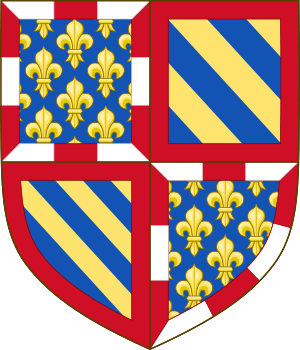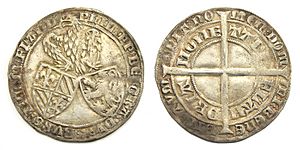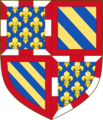Philip the Bold facts for kids
Quick facts for kids Philip II the Bold |
|
|---|---|
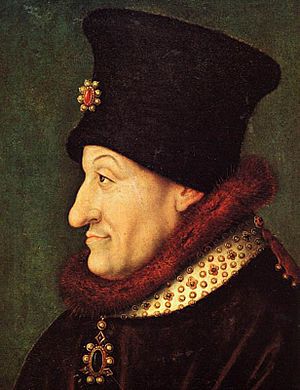
Later copy of an early 15th-century portrait of Philip, possibly by Jean Malouel
|
|
| Duke of Burgundy | |
| Reign | 6 September 1363 – 27 April 1404 |
| Predecessor | Philip I |
| Successor | John the Fearless |
| Born | 17 January 1342 Pontoise, France |
| Died | 27 April 1404 (aged 62) Halle, County of Hainaut |
| Spouse |
Margaret III of Flanders
(m. 1369) |
| Issue among others |
|
| House | Valois-Burgundy |
| Father | John II of France |
| Mother | Bonne of Bohemia |
Philip II the Bold (French: Philippe II le Hardi; Dutch: Filips de Stoute; born January 17, 1342 – died April 27, 1404) was an important ruler in Europe. He was the Duke of Burgundy and also became the Count of Flanders, Artois, and Burgundy through his marriage.
Philip was the youngest son of King John II of France. He started the Burgundian branch of the House of Valois, a powerful family. His large collection of lands made him one of the most important nobles in France. His family became very strong, even challenging the kings of France later on.
Philip II also helped improve gunpowder artillery. He used these new weapons successfully in his battles.
Contents
Becoming Philip the Bold
Philip was born in Pontoise, France, in 1342. His father, John, became the king of France in 1350. Philip earned the nickname "the Bold" when he was only 14 years old.
This happened during the Battle of Poitiers in 1356. He fought bravely alongside his father. Both of them were captured by the English during this battle. They stayed prisoners until a peace agreement, the Treaty of Brétigny, was signed in 1360.
In 1360, Philip was given the title of duke of Touraine. But in 1363, he gave this land back to the king. Instead, his father rewarded his courage by giving him the important Duchy of Burgundy.
Marriage and New Lands
On June 19, 1369, Philip married Margaret. She was 19 years old and the daughter of Count Louis II of Flanders. This marriage was very important for Philip.
Margaret later inherited many rich lands. These included the County of Flanders, the Duchy of Brabant, the County of Artois, and the Free County of Burgundy. Because of his marriage, Philip gained control of these territories.
From 1379 to 1382, Philip helped his father-in-law, Louis II. They worked to stop revolts in Flanders, especially in the city of Ghent. Philip organized an army against the rebel leader Philip van Artevelde. The revolts finally ended in 1385 with the Peace of Tournai.
After Louis II died, Philip became the Count of Flanders through his wife. He made sure to support the economy of the Flemish cities. These cities made a lot of money from weaving and spinning cloth. He also helped expand the local parliament, adding more representatives.
In 1390, Philip also became the Count of Charolais. This was another important title used by future rulers of Burgundy.
Philip's Role in France
Philip was very involved in the French royal court. This became even more true after his brother, King Charles V, died in 1380. Charles V's son, Charles VI, became king when he was only 11 years old.
Because Charles VI was so young, a group of his uncles ruled France for him. Philip was one of these four uncles. He quickly became the most powerful among them. He even helped stop a tax revolt in 1382.
Philip and the other uncles lost some power in 1388. This was when King Charles VI decided to listen to his own advisors instead. But in 1392, Philip gained power again. King Charles VI became very ill and showed signs of mental instability.
Philip quickly took charge and became the main ruler of France. He held this power until 1402. However, this caused problems within the royal family. The king's brother, Louis, Duke of Orléans, was unhappy that Philip was ruling instead of him.
This led to a rivalry between Philip and Louis. They argued over royal money. Philip wanted it for his lands in Burgundy and the Low Countries. Louis wanted it for his expensive lifestyle. Philip was seen as a more responsible ruler compared to Louis.
In 1395, Philip the Bold made a rule about wine. He banned the growing of the Gamay grape. He wanted only the Pinot Noir grape to be grown. This was an early example of rules to improve wine quality.
Philip died in Halle, which is now in modern Belgium, on April 27, 1404. His oldest son, John the Fearless, inherited his lands and his important role in French politics.
Philip's Tomb
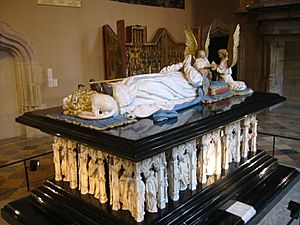
In 1378, Philip the Bold bought land near Dijon. He built a monastery there called the Chartreuse de Champmol. He wanted this monastery to be the burial place for his family.
His tomb is a famous work of art. It has his statue lying down and many small statues of mourners. Artists like Jean de Marville, Claus Sluter, and Claus de Werve worked on it. Jean Malouel added colors and gold.
After Philip died, his body was prepared and placed in a lead coffin. It was buried in the monastery on June 16, 1404. His internal organs were sent to a church in Halle. In 1792, his tomb was damaged during a revolution. It was later fixed and is now in the Musée des Beaux-Arts de Dijon, a museum in Dijon.
Philip's Family
Philip the Bold married Margaret III of Flanders on June 19, 1369. This marriage helped bring together many important lands. Philip and Margaret had several children:
- John the Fearless (1371–1419): His oldest son and the next Duke of Burgundy.
- Charles (1372–1373)
- Marguerite (1374–1441): She married William VI, Count of Holland.
- Louis (1377–1378)
- Catherine (1378–1425): She married Leopold IV, Duke of Austria.
- Bonne (1379–1399)
- Antoine, Duke of Brabant (1384–1415): He died at the Battle of Agincourt.
- Mary (1386–1422): She married Amadeus VIII, Duke of Savoy.
- Philip II, Count of Nevers (1389–1415): He also died at the Battle of Agincourt.
Philip was very smart about arranging his children's marriages. He used them to create important alliances. For example, in 1385, his son John and daughter Margaret married children of Albert I, Duke of Bavaria. This helped connect Burgundy with other powerful regions like Hainault and Holland.
These marriages also linked the new Valois Burgundy family to other royal families. This included the family of Isabeau of Bavaria, who married Charles VI of France and became Queen of France. Philip also made alliances with Austria and Savoy through his daughters Catherine and Mary.
Philip's Homes
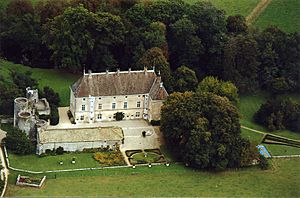
Not many of Philip the Bold's homes still exist today. Some parts of his palace in Dijon remain. But the Château de Germolles is mostly preserved.
Philip gave this castle to his wife, Margaret III, Countess of Flanders, in 1381. She turned the old fortress into a beautiful home. She used famous artists from Burgundy, like Claus Sluter and Jean de Beaumetz, to help her.
See also
 In Spanish: Felipe II de Borgoña para niños
In Spanish: Felipe II de Borgoña para niños
Images for kids
-
Later copy of an early 15th-century portrait of Philip, possibly by Jean Malouel
-
Tomb of Philip the Bold at the Palace of the Dukes of Burgundy at Dijon
-
The Château de Germolles in Burgundy.


